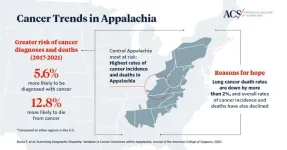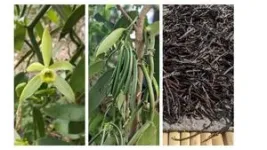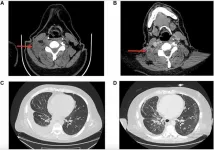(Press-News.org) Key Takeaways:
Appalachia is not uniform: There are important distinctions in cancer diagnoses and deaths among different regions of Appalachia, with certain areas of Central Appalachia experiencing the highest rates of cancer incidence and deaths among the greater Appalachian region.
Higher death rates from cancers that can be caught early with screening: Although the region has improved in screening rates, people in Appalachia still die more frequently from cancers that can be caught early with routine screening than elsewhere in the United States.
Reason for hope: Research can pave the way for targeted interventions that can reduce these disparities, the authors said.
CHICAGO: Fewer people than before are being diagnosed with and dying from cancer in Appalachia, but cancer incidence and death rates remain substantially higher, especially in certain areas of Central Appalachia, compared to elsewhere in the U.S.
The findings, published in the Journal of the American College of Surgeons (JACS), reflect the most up-to-date cancer data from the Appalachian region and include in-depth analyses within Appalachia by county.
The Appalachian region, which consists of 423 counties spanning 13 states along the eastern seaboard from Mississippi to southern New York, includes a population of more than 26 million. Abundant in rich folk culture and natural scenery, the region unfortunately also has faced considerable disparities in cancer rates in recent decades. But past research has not focused on granular data at the county level, the authors said.
“The Appalachian region is so large, so to view it as monolithic I think is shortsighted,” said Todd Burus, MAS, a data scientist at the Markey Cancer Center of the University of Kentucky and first author of the JACS study. “The experiences of people living in different regions of Appalachia, particularly in the coal mining areas of eastern Kentucky or West Virginia, are vastly different than it is for individuals in other places. With this research, we sought to understand those unique regional differences to learn how we can better improve cancer screening and treatment strategies.”
Some Progress, but Not Enough
Using data from the U.S. Census Bureau, the U.S. Cancer Statistics Incidence Analytics Database, and the National Center for Health Statistics, the authors examined cancer incidence and death rates from 2017 to 2021 and overall cancer trends between 2004 and 2021. Some of their main findings were:
Greater risk of cancer: From 2017 to 2021, people living in the Appalachian region were 5.6% more likely to be diagnosed with cancer and 12.8% more likely to die from cancer compared to those living outside the Appalachian region.
Higher death rates from cancers that are routinely screened: Although the region has improved in screening rates, more people still die of cancers that can be caught early with routine screening (breast, colorectal, cervical, and lung) in Appalachia compared to other U.S. regions outside of Appalachia.
Variations between Appalachian subregions: Within Appalachia, the Central subregion — predominately eastern Kentucky with parts of Virginia, Tennessee, and West Virginia — had the highest rates of cancer incidence and deaths, highlighting the need to increase outreach and research in these areas to better understand and reduce these disparities, researchers said.
Concerning upticks in liver and late-stage cervical cancers: Between 2004 and 2021, the number of people diagnosed with liver and intrahepatic bile duct cancers dramatically increased in Appalachia — by about 3.77% per year, which is almost twice as fast as outside of the Appalachian region. These cancers are associated with chronic hepatitis C, a liver disease associated with intravenous drug use. Rates of late-stage cervical cancer incidence, which is most often caused by the human papillomavirus (HPV) and is largely preventable with routine screening and vaccination, also increased by 0.51% per year in the Appalachian region while remaining static in other parts of the U.S.
Some progress, but not enough: Overall rates of cancer incidence (-0.33%) and deaths (-1.39%) are decreasing in Appalachia, but they aren’t declining as fast as areas outside of Appalachia. In regions outside of Appalachia, cancer incidence rates decreased by 0.55% from 2004 to 2021 and death rates decreased by 1.67% from 2004 to 2020.
Targeted Strategies Can Improve Care
Reasons for these disparities are complex, stemming from limited access to care in rural regions, historical occupational risks from coal mining and other hazardous industries, and higher poverty rates, the authors noted. Other factors, such as higher prevalence of obesity, smoking, and lower HPV vaccination rates, also likely contribute to the widening disparities. Although the disparities are concerning, great strides can be made to close these gaps and improve care, they added.
“From a clinical standpoint, it’s important for us to understand the differences in cancer care and overall rates depending upon the region of Appalachia,” said B. Mark Evers, MD, FACS, senior author of the study and director of the Markey Cancer Center. “Being able to understand where these disparities exist at the county level within Appalachia allows us to better focus our screening techniques and prevention strategies.”
Dr. Evers cited recent public health initiatives that helped boost lung cancer screening rates in Kentucky above the national average for at-risk patients. Lung cancer death rates in Appalachia are down by 2.5%, and late-stage lung cancer rates are down by about 2.2%, with the largest period of decline associated with the advent of lung cancer screening recommendations from the U.S. Preventive Services Task Force, according to the JACS paper. These positive trends demonstrate the influence that public health campaigns and targeted interventions can have on at-risk populations, Dr. Evers added.
“There are reasons for hope and opportunities to increase access to preventive care in at-risk populations throughout Appalachia, especially as we learn from this data where to focus on some of these problems that have been persistent for decades,” Dr. Evers said.
Study coauthors with Dr. Evers and Mr. Burus are: Pamela C. Hull, PhD; Krystle A. Lang Kuhs, PhD, MPH; Tianyan Gao, PhD; and Christine F. Brainson, PhD.
This study was published as an article in press on the JACS website and presented at the Southern Surgical Association 136th Annual Meeting in Palm Beach, Florida, December 2024.
Disclosure: No disclosures.
Citation: Burus T, Hull P, Lang Kuhs K, et al. Examining Geographic Disparity: Variation in Cancer Outcomes within Appalachia. Journal of the American College of Surgeons, 2025. DOI: 10.1097/XCS.0000000000001273
# # #
About the American College of Surgeons
The American College of Surgeons (ACS) is a scientific and educational organization of surgeons that was founded in 1913 to raise the standards of surgical practice and improve the quality of care for all surgical patients. The ACS is dedicated to the ethical and competent practice of surgery. Its achievements have significantly influenced the course of scientific surgery in America and have established it as an important advocate for all surgical patients. The ACS has approximately 90,000 members and is the largest organization of surgeons in the world. “FACS” designates that a surgeon is a Fellow of the ACS.
Follow the ACS on social media: X | Instagram | YouTube | LinkedIn | Facebook
CONTACT:
Sheila Lai | 312-202-5403
Dan Hamilton | 312-202-5328
Email: pressinquiry@facs.org
END
Cancer diagnoses and deaths are declining in Appalachia but remain significantly higher compared to other US regions
Despite some progress in reducing cancer deaths, people in Appalachia are more likely to be diagnosed with and die from cancer compared to other regions, researchers found
2025-02-06
ELSE PRESS RELEASES FROM THIS DATE:
Why some heavy drinkers develop advanced liver disease, while others do not
2025-02-06
LOS ANGELES — Why do some people who consume a few glasses of alcohol a day develop advanced liver disease while others who drink the same amount don’t?
The answer may lie in three common underlying medical conditions, according to a new study published in Clinical Gastroenterology and Hepatology from Keck Medicine of USC. The research found that heavy drinkers with either diabetes, high blood pressure or a high waist circumference are as much as 2.4 times more likely to develop advanced liver disease.
“The results ...
OmicsFootPrint: Mayo Clinic’s AI tool offers a new way to visualize disease
2025-02-06
ROCHESTER, Minnesota — Mayo Clinic researchers have pioneered an artificial intelligence (AI) tool, called OmicsFootPrint, that helps convert vast amounts of complex biological data into two-dimensional circular images. The details of the tool are published in a study in Nucleic Acids Research.
Omics is the study of genes, proteins and other molecular data to help uncover how the body functions and how diseases develop. By mapping this data, the OmicsFootPrint may provide clinicians and researchers with a new way to visualize ...
New genetic mutation linked to drug resistance in non-small cell lung cancer patient
2025-02-06
“Here we present a case of a patient with stage IV CD-74-ROS1 fusion NSCLC discovered initially with RNA next generation sequencing (NGS) who acquired resistance to lorlatinib after 6 months on therapy through a novel RUFY1-RET fusion, detected only through RNA NGS.”
BUFFALO, NY - February 6, 2025 – A new case report was published in Volume 16 of Oncotarget on February 5, 2025, titled “Acquired RUFY1-RET rearrangement as a mechanism of resistance to lorlatinib in a patient with CD74-ROS1 rearranged non-small cell lung cancer: A case report."
In this case report, Jenny L. ...
Single-photon LiDAR delivers detailed 3D images at distances up to 1 kilometer
2025-02-06
WASHINGTON — Researchers have designed a single-photon time-of-flight LiDAR system that can acquire a high-resolution 3D image of an object or scene up to 1 kilometer away. The new system could help enhance security, monitoring, and remote sensing by enabling detailed imaging even in challenging environmental conditions or when objects are obscured by foliage or camouflage netting.
“Our system uses a single-photon detector approximately twice as efficient as detectors deployed in similar LiDAR systems ...
Fear of breast cancer recurrence: Impact and coping with being in a dark place
2025-02-06
INDIANAPOLIS – Breast cancer is the world’s most prevalent cancer. Although earlier detection and targeted treatment have resulted in high survival rates, many breast cancer survivors experience fear of cancer recurrence. For some survivors this fear is occasional, for others it is persistent and often debilitating.
A new study of breast cancer survivors has found this psychosocial challenge impacts almost every important domain of their lives – the emotional, behavioral, cognitive, relational and professional. A larger number of domains was affected, ...
Korea University researchers analysis of income-related disparities in mortality among young adults with diabetes
2025-02-06
Korea University Researchers Analysis of Income-Related Disparities in Mortality Among Young Adults with Diabetes
Type 2 diabetics (T2D) under 40 years of age with low income have a threefold higher risk of mortality
Young people with T2D are more affected by income than elderly people with T2D
The research team of Professor Sin Gon Kim and Professor Nam Hoon Kim of department of internal medicine (Endocrinology and Metabolism) of Korea University Anam Hospital, and Professor Ji Yoon Kim of Samsung Medical Center confirmed that young adults with T2D with low income have 3 times higher mortality ...
Study shows link between income inequality and health and education disparities may drive support for economic reform
2025-02-06
New research forthcoming in Social Psychological and Personality Science shows that when people understand how income inequality creates disparities in healthcare and education access, they become more likely to support policies addressing economic inequality.
Across four studies, the research shows that highlighting connections between income gaps and inequalities in health and education access decreases acceptance of economic disparities and increase support for redistributive actions.
"Research has shown that people often tolerate income inequality. However, our study shows that when people perceive ...
HonorHealth Research Institute’s Chief Medical Officer is recognized by the world’s leading organization for cancer doctors
2025-02-06
SCOTTSDALE, Ariz. — Feb. 6, 2025 — Michael S. Gordon, M.D., Chief Medical Officer of HonorHealth Research Institute, today was named a Fellow of the American Society of Clinical Oncology (FASCO), the world’s leading professional organization for physicians and oncology professionals caring for people with cancer.
“The title of FASCO is a recognition bestowed upon ASCO members who have shown extraordinary dedication for their voluntary efforts that benefit the Society, the specialty of oncology, and most importantly, the patients whom we serve,” according to a letter ...
InsectNet technology identifies insects around the world and around the farm
2025-02-06
AMES, Iowa – A farmer notices an unfamiliar insect on a leaf.
Is this a pollinator? Or a pest? Good news at harvest time? Or bad? Need to be controlled? Or not?
That farmer can snap a picture, use a smartphone or computer to feed the photo into a web-based application called InsectNet and, with the help of machine learning technology, get back real-time information.
“The app identifies the insect and returns a prediction of its taxonomic classification and role in the ecosystem as a pest, predator, pollinator, parasitoid, decomposer, herbivore, indicator ...
Restoring predators, restoring ecosystems: Yellowstone wolves and other carnivores drive strong trophic cascade
2025-02-06
Restoring Predators, Restoring Ecosystems: Yellowstone Wolves and other Carnivores Drive Strong Trophic Cascade
Corvallis, OR — February 6, 2025 — A new study reveals the profound ecological effects of wolves and other large carnivores in Yellowstone National Park, showcasing the cascading effects predators can have on ecosystems. In Yellowstone, this involves wolves and other large carnivores, elk, and willows. The research, which utilized previously published data from 25 riparian (streamside) ...
LAST 30 PRESS RELEASES:
NTP-enhanced lattice oxygen activation in Ce-Co catalysts for low-temperature soot combustion
Synergistic interface engineering in Cu-Zn-Ce catalysts for efficient CO2 hydrogenation to methanol
COVID-19 leaves a lasting mark on the human brain
Scientists use ultrasound to soften and treat cancer tumors without damaging healthy tissue
Community swimming program for Black youth boosts skills, sense of belonging, study finds
Specific depressive symptoms in midlife linked to increased dementia risk
An ‘illuminating’ design sheds light on cholesterol
Who is more likely to get long COVID?
Study showcases resilience and rapid growth of “living rocks”
Naval Research Lab diver earns Office of Naval Research 2025 Sailor of the Year
New Mayo-led study establishes practical definition for rapidly progressive dementia
Fossil fuel industry’s “climate false solutions” reinforce its power and aggravate environmental injustice
Researchers reveal bias in a widely used measure of algorithm performance
Alcohol causes cancer. A study from IOCB Prague confirms damage to DNA and shows how cells defend against it
Hidden viruses in wastewater treatment may shape public health risks, study finds
Unlock the power of nature: how biomass can transform climate mitigation
Biochar reshapes hidden soil microbes that capture carbon dioxide in farmland
Reducing saturated fat intake shows mortality benefit, but only in high-risk individuals
Manta rays create mobile ecosystems, study finds
Study: Mixed results in using lipoic acid to treat progressive multiple sclerosis
Norbert Holtkamp appointed director of Fermi National Accelerator Laboratory
New agentic AI platform accelerates advanced optics design
Biologists discover neurons use physical signals — not electricity — to stabilize communication
Researchers discover that a hormone can access the brain by hitchhiking
University of Oklahoma researcher awarded funding to pursue AI-powered material design
Exploring how the visual system recovers following injury
Support for parents with infants at pediatric check-ups leads to better reading and math skills in elementary school
Kids’ behavioral health is a growing share of family health costs
Day & night: Cancer disrupts the brain’s natural rhythm
COVID-19 vaccination significantly reduces risk to pregnant women and baby
[Press-News.org] Cancer diagnoses and deaths are declining in Appalachia but remain significantly higher compared to other US regionsDespite some progress in reducing cancer deaths, people in Appalachia are more likely to be diagnosed with and die from cancer compared to other regions, researchers found








